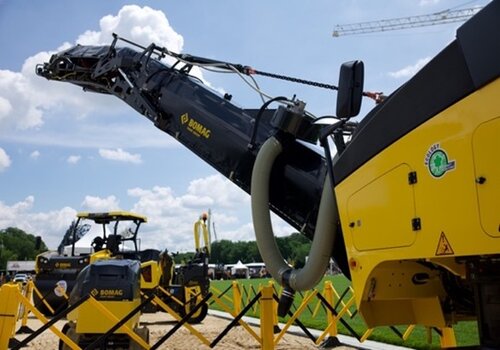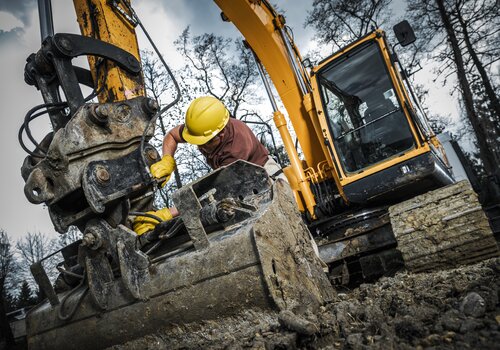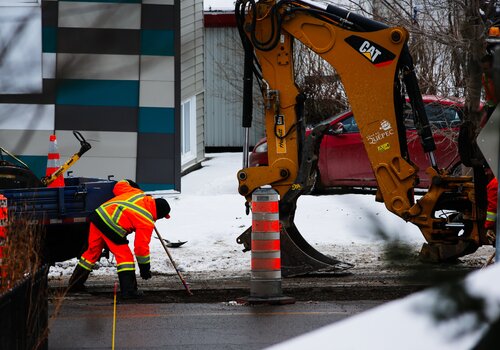Pouring concrete on upper levels of multi-story buildings comes with a number of challenges. Contractors have several options to accomplish this—crane, boom truck and tilt-wall construction.
Cranes are used to transport vats (called skips) of concrete to upper levels of buildings. A boom truck is a truck equipped with a long tube-like appendage which unfolds, extends and rotates to place concrete. Tilt-wall construction involves pouring concrete into molds at ground level and then raising the molds into place via a mobile crane.
Hoist
Since installing a tower crane is a time-consuming and intrusive task that requires an engineer, it would only be used if the project required a tower crane for other duties.
When this is the preferred method, several mixer trucks sit near the bottom of the building. The crane places the vat (called a skip) near the truck and the mixer operator fills it. The crane then hoists the skip to the point of placement where a team of people are waiting for it.
When using tower cranes, the skip is usually not filled all the way and crane operators work more cautiously when craning liquids. Liquids move differently than solid materials when being craned, so spillage is more likely to occur. It also may be deemed necessary to move the skip along a route that is not the most direct route, since the risk of spilling concrete onto what lies below may be too great.
Of the three methods, cranes offer the slowest production rates, so it’s often better to use a boom truck than a mobile crane.
Pump
The boom truck is the most popular method for placing concrete on multi-story buildings.
“The largest KCP boom trucks can place concrete 200 feet up or across,” says Jeff Loberg, Regional Sales Manager, KCP Pumps. “They are each equipped with a 425-hp Mack Trucks engine that powers two pumps capable of production rates between 1,000 and nearly 1,400 psi. You need a lot of power to push up the concrete. The higher you push up concrete, the more gravity fights you.”
The major drawback to this method is finding space that is close to where the concrete will be placed that is large enough to accommodate a large truck equipped with long outriggers. Construction sites are notoriously congested areas, so boom trucks often place concrete parked in the street.
Parking on the street requires a permit and potentially staff to monitor pedestrian activity near the boom truck. Also, if you are placing concrete from the road, you will need a truck with a longer boom, and that comes with a bigger price tag.
However, concrete pumps offer few risks of injury or damage. So long as the truck is positioned with its outriggers extended in a way that maximizes the stability of the truck and the operator unfolds the boom away from nearby structures or equipment and moves the boom safely around people and objects, concrete pumps offer fairly safe and fast concrete placement.
The largest risk to placing concrete higher up is that you still have people working at height, and that creates a fall risk.
Pour
Tilt-wall construction (sometimes called tilt-slab construction) is a growing popular alternative. The method was established in the US more than a century ago and has existed as a niche construction method since then.
Pouring concrete at ground level is safer than pouring concrete at height. People don’t have to be on upper levels of buildings, so there is less risk of falls and injuries as the result of being struck by something dropped from higher up.
The biggest risk to tilt-wall construction is when the slabs are erected; mobile cranes lift and sometimes transport entire, multi-story concrete walls into position. Until those slabs are fastened to adjacent walls, there is a chance that the slabs will fall.
“Ninety percent of the tilt-up process happens at ground level, so in reality even though there is a fear factor to the massive panels that we erect, it is a very safe process,” says Len Overbeek, President, Tiltwall Ontario. “Also, weather can play a factor in outdoor construction, but many advancements in concrete technology have helped mitigate most of the issues to working with concrete in adverse weather environments.
Tilt-wall construction also requires a lot of space. Since these multi-story slabs are laid face up on the ground, each slab takes up a lot of space, so this method is not conducive to projects located in tight areas, such as many downtowns of large cities.
And tilt-wall construction is more costly than traditional construction, however, buildings created via the tilt-wall method offer significant energy savings, which make the cost owning and operating the building much less.
Join more than 40,000 industry peers who receive construction industry news and trends each week. Subscribe to CONEXPO-CON/AGG 365.












